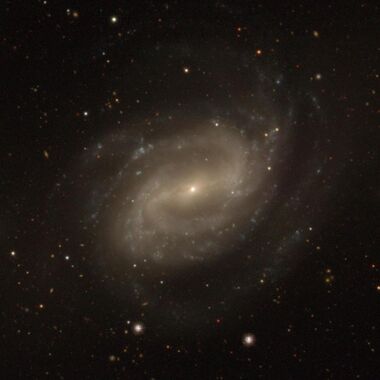Astronomy:NGC 4123
| NGC 4123 | |
|---|---|
 NGC 4123 with Legacy Surveys DR10 | |
| Observation data (J2000 epoch) | |
| Right ascension | 12h 08m 11.119s[1] |
| Declination | +02° 52′ 41.78″[1] |
| Redshift | 0.00429±0.00002[2] |
| Helio radial velocity | 1,326[3] km/s |
| Distance | 75 ± 14 Mly (22.9 ± 4.2 Mpc)[4] |
| Apparent magnitude (V) | 11.4[5] |
| Apparent magnitude (B) | 13.10[3] |
| Characteristics | |
| Type | SBx(rs)ab[6] |
| Mass/Light ratio | 2.25[7] M☉/L☉ |
| Apparent size (V) | 1.900′ × 0.646′[8] (NIR) |
| Other designations | |
| NGC 4123, UGC 7116, PGC 38531, LEDA 38531, Mrk 1466[9] | |
NGC 4123 is a modest-sized,[10] strongly-barred spiral galaxy[7] located 75 million light-years[4] away in the equatorial constellation of Virgo. It was discovered February 25, 1784 by William Herschel.[5] This is a member of the Virgo cluster, and it belongs to a group of three galaxies.[11] A companion galaxy, NGC 4116, lies at an angular separation of 14′ to the southwest. There is no indication of an interaction between the two galaxies.[7] The third member of the group is NGC 4179.[11]

The morphological classification of NGC 4123 is SBx(rs)ab, which indicates this is a spiral galaxy with a central X-shaped bar (SBx) encircled by an incomplete ring structure (rs) and moderate to tightly wound spiral arms (ab). The plane of the galaxy is inclined at an angle of 46.9° to the line of sight from the Earth. It lacks a large spheroidal bulge at the core, showing only a luminous point-like source.[10] Blue knots in the outer spiral arms indicate that star formation is ongoing.[7] The galaxy has a stellar mass of 1.95×1010 M☉[6] with a star formation rate of 3.429±3.281 M☉·yr−1.[12] The atomic gas in the galaxy has a mass of 1.06×1010 M☉.[10]
Radio emission has been detected from an HII nucleus, which is consistent with it having a weak active galactic nucleus.[13] If there is a supermassive black hole at the core, it has an estimated mass of 107 M☉.[14]
References
- ↑ 1.0 1.1 Vallenari, A. et al. (2022). "Gaia Data Release 3. Summary of the content and survey properties". Astronomy & Astrophysics. doi:10.1051/0004-6361/202243940 Gaia DR3 record for this source at VizieR.
- ↑ Abazajian, Kevork N. et al. (2009), "The Seventh Data Release of the Sloan Digital Sky Survey", The Astrophysical Journal Supplement Series 182 (2): 543–558, doi:10.1088/0067-0049/182/2/543, Bibcode: 2009ApJS..182..543A.
- ↑ 3.0 3.1 Voyer, E. N. et al. (September 2014), "The GALEX Ultraviolet Virgo Cluster Survey (GUViCS). III. The ultraviolet source catalogs", Astronomy & Astrophysics 569: A124, doi:10.1051/0004-6361/201322511, A124, Bibcode: 2014A&A...569A.124V.
- ↑ 4.0 4.1 Haynes, Martha P. et al. (July 2018), "The Arecibo Legacy Fast ALFA Survey: The ALFALFA Extragalactic H I Source Catalog", The Astrophysical Journal 861 (1): 49, doi:10.3847/1538-4357/aac956, 49, Bibcode: 2018ApJ...861...49H.
- ↑ 5.0 5.1 Seligman, Courtney, "NGC Objects: NGC 4100 - 4149", Celestial Atlas, https://cseligman.com/text/atlas/ngc41.htm#4123, retrieved 2023-11-04.
- ↑ 6.0 6.1 Díaz-García, S. et al. (October 2021), "Molecular gas and star formation within 12 strong galactic bars observed with IRAM-30 m", Astronomy & Astrophysics 654: A135, doi:10.1051/0004-6361/202140674, A135, Bibcode: 2021A&A...654A.135D.
- ↑ 7.0 7.1 7.2 7.3 Weiner, Benjamin J.; Williams, T. B.; van Gorkom, J. H.; Sellwood, J. A. (January 2001), "The Disk and Dark Halo Mass of the Barred Galaxy NGC 4123. I. Observations", The Astrophysical Journal 546 (2): 916–930, doi:10.1086/318288, Bibcode: 2001ApJ...546..916W.
- ↑ Skrutskie, Michael F. et al. (1 February 2006), "The Two Micron All Sky Survey (2MASS)", The Astronomical Journal 131 (2): 1163–1183, doi:10.1086/498708, ISSN 0004-6256, Bibcode: 2006AJ....131.1163S.
- ↑ "NGC 4123". SIMBAD. Centre de données astronomiques de Strasbourg. http://simbad.u-strasbg.fr/simbad/sim-basic?Ident=NGC+4123.
- ↑ 10.0 10.1 10.2 Weiner, Benjamin J. et al. (January 2001), "The Disk and Dark Halo Mass of the Barred Galaxy NGC 4123. II. Fluid-Dynamical Models", The Astrophysical Journal 546 (2): 931–951, doi:10.1086/318289, Bibcode: 2001ApJ...546..931W.
- ↑ 11.0 11.1 Kim, Suk; Rey, Soo-Chang; Jerjen, Helmut; Lisker, Thorsten; Sung, Eon-Chang; Lee, Youngdae; Chung, Jiwon; Pak, Mina et al. (December 2014), "The Extended Virgo Cluster Catalog", The Astrophysical Journal Supplement 215 (2): 22, doi:10.1088/0067-0049/215/2/22, 22, Bibcode: 2014ApJS..215...22K.
- ↑ Lianou, S. et al. (November 2019), "Dust properties and star formation of approximately a thousand local galaxies", Astronomy & Astrophysics 631: A38, doi:10.1051/0004-6361/201834553, A38, Bibcode: 2019A&A...631A..38L.
- ↑ Ulvestad, James S.; Ho, Luis C. (December 2002), "A Search for Active Galactic Nuclei in Sc Galaxies with H II Spectra", The Astrophysical Journal 581 (2): 925–931, doi:10.1086/344442, Bibcode: 2002ApJ...581..925U.
- ↑ Dong, X. Y.; De Robertis, M. M. (March 2006), "Low-Luminosity Active Galaxies and Their Central Black Holes", The Astronomical Journal 131 (3): 1236–1252, doi:10.1086/499334, Bibcode: 2006AJ....131.1236D.
Further reading
- Weiner, B. J. et al. (1996), Buta, R.; Crocker, D. A.; Elmegreen, B. G., eds., "Fabry-Perot Observations and Hydrodynamical Simulations of the Barred Spiral NGC 4123", Barred galaxies; Proceedings of a conference held at the University of Alabama; Tuscaloosa; Alabama; 30 May - 3 June 1995, Astronomical Society of the Pacific Conference Series (San Francisco: Astronomical Society of the Pacific) 91: p. 489, Bibcode: 1996ASPC...91..489W.
 |

